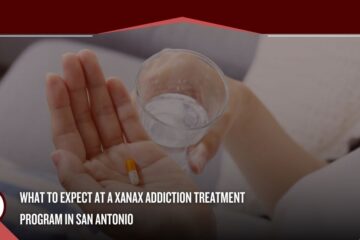Dual diagnosis refers to the co-occurrence of a mental health disorder and substance use disorder in an individual. It is a complex and challenging condition that requires comprehensive and integrated treatment approaches. Therefore, the significance of dual diagnosis in addiction treatment cannot be overstated. When individuals struggle with both mental health and substance use disorders, their conditions often interact, exacerbating symptoms and hindering recovery. Effective treatment for dual diagnosis is crucial to address the underlying causes of addiction and mental health issues simultaneously. Thus, the importance of employing effective therapeutic modalities, such as inpatient dual diagnosis treatment centers in Texas becomes evident. They encompass a range of evidence-based interventions, such as cognitive-behavioral therapy, dialectical behavior therapy, motivational interviewing, and medication-assisted treatment, among others. Implementing these therapeutic modalities in dual diagnosis treatment in Texas can provide individuals with the necessary support to achieve lasting recovery.
Goals and Objectives of the Dual Diagnosis Treatment
Navigating the complexities of therapeutic modalities in dual diagnosis treatment in Texas requires specialized treatment programs, such as those included under the psychotherapy for addiction in San Antonio that address both the mental health and substance use components. Dual-diagnosis treatment programs aim to provide integrated care by combining therapeutic interventions and support services tailored to the unique needs of individuals with co-occurring disorders. These programs emphasize a multidisciplinary approach, bringing together psychiatrists, addiction specialists, therapists, and other professionals to collaborate on comprehensive treatment plans.

Dual-diagnosis treatment programs have a primary goal: to address both mental health disorders and substance use disorders simultaneously for recovery. These programs aim to enhance individuals’ quality of life by reducing mental illness symptoms, managing cravings and withdrawal, promoting sobriety, and preventing relapse. Moreover, the objectives encompass holistic care through psychoeducation, individual and group therapy, medication management, and the development of coping skills and relapse prevention strategies.
In Texas, dual-diagnosis treatment programs commit to restoring individuals’ mental health and supporting their journey toward lasting recovery. They also recognize the interconnectedness of mental health and substance use, offering integrated approaches to address underlying causes. These comprehensive goals and objectives highlight the dedication of dual diagnosis treatment programs in helping individuals achieve holistic well-being and sustained recovery.
Cognitive-Behavioral Therapy (CBT) in Dual Diagnosis Treatment
Cognitive-Behavioral Therapy (CBT) is a widely recognized and effective therapeutic modality used in dual-diagnosis treatment programs. It focuses on identifying and changing negative thought patterns and behaviors, empowering individuals to develop healthier coping strategies.
Cognitive-Behavioral Therapy (CBT) is a psychotherapeutic approach that aims to modify unhealthy thoughts, emotions, and behaviors. In dual diagnosis treatment, CBT generally helps individuals with co-occurring disorders identify the connections between their thoughts, feelings, and substance use.

Through challenging negative beliefs and distorted thinking patterns, CBT enables clients to develop more constructive ways of thinking and responding to triggers. Firstly, it equips them with the skills to manage cravings and cope with stress. Secondly, CBT’s adaptability and evidence-based foundation make it a valuable tool in dual diagnosis treatment.
Effectiveness of CBT in Dual Diagnosis
Research has consistently shown the effectiveness of CBT in treating co-occurring disorders. In addition, CBT interventions have been found to reduce substance use, decrease symptoms of mental health disorders, and improve overall functioning. By targeting the underlying thoughts and behaviors that contribute to the dual diagnosis, CBT facilitates lasting change. It helps individuals develop self-awareness, improve emotional regulation, and enhance problem-solving skills. Moreover, CBT equips individuals with relapse prevention strategies and encourages them to take an active role in their recovery journey. The integration of CBT in dual-diagnosis treatment has shown promising outcomes in breaking the cycle of addiction and mental health challenges.
How CBT Techniques Are Used in Dual Diagnosis Treatment
In dual diagnosis treatment, CBT techniques are applied in various ways to address co-occurring disorders effectively. Some of them are:
- Cognitive restructuring – clients learn to identify and challenge negative thoughts and replace them with positive and realistic ones
- Skills training – individuals acquire coping skills, stress management techniques, and problem-solving abilities
- Behavioral activation – clients are engaged in rewarding and healthy activities as an alternative to substance use
- Exposure therapy – helps individuals confront and overcome specific fears or triggers
These examples highlight the versatility and efficacy of CBT in dual diagnosis treatment, supporting individuals in their path to recovery.
Motivational Interviewing (MI) in Dual Diagnosis Treatment
Motivational Interviewing (MI) is a person-centered approach that aims to evoke individuals’ internal motivation and resolve their ambivalence towards change. In the context of dual diagnosis treatment, MI plays a crucial role in facilitating positive behavioral transformations and promoting long-term recovery. Through MI, therapists create a collaborative and empathetic environment where individuals feel heard, respected, and supported. The goal is to elicit and strengthen their intrinsic motivation to make positive changes in their lives. MI recognizes that change is a personal process and respects individuals’ autonomy in decision-making.

Research has shown the effectiveness of MI in dual diagnosis treatment, with positive outcomes in reducing substance use, enhancing treatment engagement, and improving treatment retention. MI techniques, such as reflective listening, open-ended questions, and affirmations, are employed to enhance individuals’ self-efficacy and self-motivation. In dual diagnosis, MI is integrated into individual counseling sessions, family therapy for addiction, and also group therapy. It helps individuals explore their ambivalence toward change, identify barriers and strengths, and develop personalized strategies to overcome obstacles.
Dialectical Behavior Therapy (DBT)—One of the Therapeutic Modalities in Dual Diagnosis Treatment in Texas
Dialectical Behavior Therapy (DBT) enhances emotional regulation, interpersonal skills, and mindfulness. In dual diagnosis treatment, DBT equips individuals with tools to manage intense emotions, improve relationships, and break destructive patterns. It also fosters resilience, healthier connections, and positive change. DBT plays a crucial role in guiding individuals toward well-being and recovery. It combines elements of cognitive-behavioral therapy with Eastern mindfulness practices. It teaches individuals skills to tolerate distress, regulate emotions, effectively communicate, and engage in self-soothing activities. DBT also emphasizes the importance of mindfulness to cultivate present-moment awareness and reduce impulsivity.
Studies have shown the effectiveness of DBT in addressing co-occurring disorders. It helps individuals gain control over impulsive and self-destructive behaviors while increasing their ability to cope with intense emotions. Through individual therapy, group skills training, and phone coaching, DBT provides a comprehensive approach to dual diagnosis treatment.
Group Therapy in Dual Diagnosis Treatment
Group therapy is an integral component of dual diagnosis treatment programs. It provides individuals with a supportive and empathetic environment to share their experiences, struggles, and successes. Through group therapy for addiction, participants gain a sense of belonging and realize that they are not alone in their journey. It offers a unique opportunity for peer support, as individuals can learn from one another, offer insights, and receive validation. Group therapy also provides a safe space for practicing interpersonal skills, communication, and conflict resolution, which are vital for maintaining healthy relationships during recovery. Additionally, the group dynamic allows individuals to witness the progress and growth of others, providing hope and inspiration for their own healing.

Psychoeducational groups focus on providing information and teaching essential skills related to mental health and addiction. Process-oriented groups delve into personal experiences, emotions, and interpersonal dynamics, fostering self-reflection and insight. Professionals offering programs like trauma-informed treatment for addiction are aware that support groups provide a space for individuals to receive encouragement and guidance from peers who have similar experiences, such as veterans.
Medication-Assisted Treatment (MAT) in Dual Diagnosis Treatment
Medication-Assisted Treatment (MAT) is a comprehensive approach that combines medications with therapy and support to address both substance use and mental health disorders. MAT utilizes medications approved by the FDA to help individuals manage withdrawal symptoms and cravings and stabilize their mental health. Some of these medication are:
- Buprenorphine
- Naltrexone
- Methadone
Medication assisted treatment for addiction in Texas can significantly improve treatment outcomes providing a vital tool in the journey toward sustainable recovery.
Holistic Therapies as a Therapeutic Modality in Dual Diagnosis Treatment
Mind-body therapies play a significant role in dual diagnosis treatment, addressing the interconnectedness of mental and physical well-being. Therapies such as yoga, meditation, and mindfulness-based practices promote relaxation, stress reduction, and emotional balance. These practices enhance self-awareness, regulate emotions, and cultivate a sense of inner peace and resilience.

Expressive arts therapies, including art therapy, music therapy, and dance/movement therapy, provide individuals with creative outlets for self-expression and emotional healing. So, these modalities tap into individuals’ inherent creativity, allowing them to explore and process their thoughts, emotions, and experiences in nonverbal ways. Expressive arts therapies foster self-discovery, personal growth, and self-esteem, promoting overall well-being in dual diagnosis treatment.
The Importance of Individualized Treatment Plans for Dual Diagnosis
In therapeutic modalities in dual diagnosis treatment in Texas, recognizing the importance of individualized treatment plans is essential. Hence, each person’s journey to recovery is unique, requiring a personalized approach that considers their specific needs, strengths, and challenges. Besides, this individualized approach acknowledges the complexity of co-occurring disorders and ensures that treatment addresses the underlying causes of addiction and mental health issues.
Developing individualized treatment plans involves a comprehensive assessment of each client’s unique needs, strengths, and challenges. This assessment considers factors such as their history, severity of mental health and substance use disorders, social support system, and personal goals. It is crucial to recognize and build upon the individual’s strengths and existing coping mechanisms, empowering them to engage in their recovery journey actively.
Role of Comprehensive Assessments in Guiding Treatment Planning
Comprehensive assessments serve as a critical foundation for guiding individual therapy for addiction in dual-diagnosis cases. These assessments involve gathering information through interviews, questionnaires, and diagnostic tools. Therefore, we comprehensively understand an individual’s mental health, substance use patterns, medical history, and psychosocial factors. Additionally, the individualized treatment plans derived from these assessments ensure that interventions are targeted, effective, and aligned with the individual’s specific needs and goals.

By prioritizing individualized treatment plans in dual diagnosis treatment, professionals can optimize outcomes and increase the chances of sustainable recovery. Additionally, recognizing the uniqueness of each client’s journey allows for a tailored and comprehensive approach. This approach addresses their specific needs, harnesses their strengths, and guides them toward improved mental health and lasting recovery. With a focus on individualization, treatment plans can adapt to the diverse needs and circumstances of each person. This personalized approach empowers individuals, promotes a sense of ownership in their recovery journey, and enhances their overall well-being. By acknowledging and honoring the individuality of each client, dual-diagnosis treatment fosters a compassionate and effective environment that supports their path to sustained healing and a brighter future.
Alamo Behavioral Health—Illuminating the Path to Lasting Healing
In the realm of dual diagnosis treatment, the significance of effective therapeutic modalities cannot be overstated. By embracing an integrated and individualized approach, our medical detox in Texas can provide individuals with the support they need to overcome all of the challenges. Dual diagnosis treatment recognizes the intricate interplay between mental health and substance use disorders. Through cognitive-behavioral, dialectical behavior, holistic therapies, and motivational interviewing, individuals can develop resilience, cultivate self-awareness, and learn adaptive coping strategies.
As we journey towards the future, let us continue to advocate for effective therapeutic modalities in dual diagnosis treatment in Texas and beyond. Together, we can create a compassionate and supportive environment that uplifts individuals and inspires them to embrace their potential. Remember, no one is alone in this journey. With the right therapeutic modalities and unwavering support at our residential rehab Texas residents trust, we can overcome the challenges of dual diagnosis and embrace a future filled with hope, resilience, and renewed possibilities.





